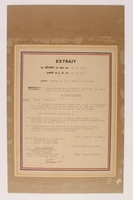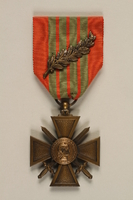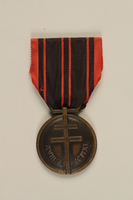Overview
- Brief Narrative
- French Military Medal awarded posthumously to 18 year old Henri Engel, a German Jew living in France, who died while fighting with the French resistance during World War II. The medal was awarded by the French Republic to honor acts of courage and dedication. It was awarded to Henri in 1960, and his sister, Margot, accepted it on his behalf in 1961. In September 1939, Henri and his mother, Lucie, were in Lyon, France, when Germany invaded Poland, prompting France and Great Britain to declare war against Germany. They were from Berlin, but were not allowed to leave and reunite with Henri’s sister, Margot, and their father, Erich. In May 1940, Germany invaded France, and occupied the northern and western regions, allowing the collaborationist Vichy government to control the south and east, including Lyon. The situation for foreign born Jews in Vichy France became progressively worse, and many faced internment and deportation. In November 1942, Germany invaded Vichy France. Henri joined the underground resistance movement and Lucie went into hiding. Henri's sister and father remained together in Berlin until Margot obtained an exit visa for Shanghai, China, and left. In March 1943, the Berlin Gestapo deported Erich to Auschwitz-Birkenau concentration camp, in German-occupied Poland, where he was killed. On August 7, 1944, Henri was arrested for acts of resistance and taken to Montluc Prison. On August 18, he was executed. Seventy-five members of Henri’s extended family were killed during the Holocaust. Lucie and Margot survived the war and later immigrated to the United States.
- Date
-
issue:
1960 May
commemoration: approximately 1942-1944 August 18
- Geography
-
issue:
France
- Credit Line
- United States Holocaust Memorial Museum Collection, Gift of Margot Engel
- Markings
- medal, front, center, embossed : REPUBLIQUE FRANCAIS [French Republic]
medal, back, center, embossed, obscured: VALEUR / ET / DISCIPLINE [Valor and Discipline] - Contributor
-
Subject:
Henri Engel
Issuer: République Française
- Biography
-
Henri Engel was born on June 20, 1926, in Berlin, Germany, to a Jewish couple, Erich and Lucie Simonin Engel. Erich was born on January 29, 1891, in Culmsee, Germany (Chełmża, Poland), to Jakob and Rosa Cohn Engel. He was a businessman. On March 3, 1915, in Frankfurt am Main, Germany, Erich married Lucie, who was French. Henri’s older sister, Margot, was born on January 9, 1916. Henri was a painter. On January 30, 1933, Adolf Hitler was appointed Chancellor of Germany. Anti-Jewish decrees were passed that restricted every aspect of Jewish life. In the mid-1930’s, conditions worsened for Jews in Germany as more punitive anti-Jewish laws were enacted. On November 9 and 10, 1938, during the Kristallnacht pogrom, Jewish people and their businesses and homes were attacked and vandalized. Following his Bar Mitzvah in summer 1939, Henri and his mother, Lucie, travelled to Lyon, France, so that he could attend boarding school there.
On September 1, 1939, Germany invaded Poland. Two days later, France and England responded by declaring war against Germany. Henri and Lucie were unable to leave France and had no way to rejoin Erich and Margot in Berlin. In May 1940, Germany invaded France, and in June German forces occupied Paris. On June 22, France signed an armistice with Germany, which allowed it to annex the provinces of Alsace and Lorraine and occupy northern and western France. Southern and eastern regions, including Lyon where Henri and Lucie were living, were referred to as the French free zone and were administered by the French collaborationist government headquartered in Vichy. In the fall, the Vichy government passed anti-Semitic legislation patterned on German laws. In March 1941, the General Commissariat for Jewish Affairs was formed to manage the new laws, enforce the confiscation of Jewish property and possessions, and supervise the internment of foreign born Jews in detention camps. Henri joined the underground French resistance movement and Lucie went into hiding. In Berlin, Margot was able to secure an exit visa for Shanghai, China, and left Berlin on the last train out. On March 3, 1943, the Berlin Gestapo put Henri’s father, Erich, on transport 35 and deported him to German-occupied Poland. On March 6, Erich’s transport train arrived at Auschwitz-Birkenau concentration camp.
On August 7, 1944, Henri was arrested for acts of resistance and imprisoned at Montluc Prison, which was under the control of Gestapo chief SS Obersturmfuhrer Klaus Barbie, the Butcher of Lyon. Prisoners lived in overcrowded conditions and were regularly tortured and interrogated. On August 18, Henri was executed. On September 3, 1944, Lyon was liberated from German control. On May 7, 1945, Germany surrendered. Henri’s mother, Lucie, survived in hiding and later immigrated to the United States. Margot married, and later she and her husband immigrated to the US. In 1960, the French Government awarded Henri three posthumous medals of resistance, which his sister, Margot, accepted on his behalf in 1961 in a ceremony in New York City. She later settled in Boca Raton, Florida. Seventy-five members of Henri’s extended family were killed in the Holocaust.
Physical Details
- Classification
-
Military Insignia
- Category
-
Medals
- Object Type
-
Medals, French (lcsh)
- Physical Description
- Circular, silver medal with a stippled, gold vermeil center ringed by a blue enamel band on both sides and an attached grosgrain ribbon. Embossed at the center is the head of a woman, Marianne, in left facing profile wearing a laurel leaf circlet. She is ringed by a band of gold colored French text with a flower set into the blue band and bordered by a laurel leaf wreath with gold vermeil ribbon accents. On the back center is embossed French text obscured beneath cardboard remnants from a previously attached backer. At the top is a fixed suspension ring attached to a link in the shape of a curved breast plate over an anchor with upward pointing, diagonally crossed cannons, halberd, and sword hilt behind. It has a flat back and a fixed ring at the top with a circular bail passing through it. Threaded through the bail is a folded, discolored ribbon with a very wide yellow center stripe flanked by light green stripes. The fraying ends are glued together on the back beneath cardboard remnants.
- Dimensions
- overall: Height: 3.875 inches (9.843 cm) | Width: 1.500 inches (3.81 cm) | Depth: 0.250 inches (0.635 cm)
- Materials
- overall : silver, vermeil, ribbon, enamel paint, adhesive, cardboard
Rights & Restrictions
- Conditions on Access
- No restrictions on access
- Conditions on Use
- No restrictions on use
Keywords & Subjects
Administrative Notes
- Legal Status
- Permanent Collection
- Provenance
- The medal was donated to the United States Holocaust Memorial Museum in 2011 by Margot Engel, the sister of Henri Engel.
- Funding Note
- The cataloging of this artifact has been supported by a grant from the Conference on Jewish Material Claims Against Germany.
- Record last modified:
- 2023-08-31 15:06:27
- This page:
- https://collections.ushmm.org/search/catalog/irn44003
Download & Licensing
In-Person Research
- By Appointment
- Request 21 Days in Advance of Visit
- Plan a Research Visit
- Request to See This Object
Contact Us
Also in Henri Engel collection
The collection consists of posthumous award certificates and medals relating to the experiences of Henri Engel as a German Jewish resistance fighter in Lyon, France during World War II.
Date: 1939-1960

Certificate for the French Resistance and Cross of War medals awarded to a German Jewish resistance fighter
Object
Certificate for French Resistance Medal and Cross of War medal awarded posthumously to 18 year old Henri Engel, a German Jew living in France, who died while fighting with the French resistance during World War II. The medals were awarded in 1960, to honor Henri as a “magnificent patriot” who died for France. His sister, Margot, accepted them on his behalf in 1961. In September 1939, Henri and his mother, Lucie, were in Lyon, France, when Germany invaded Poland, prompting France and Great Britain to declare war against Germany. They were from Berlin, but were not allowed to leave and reunite with Henri’s sister, Margot, and their father, Erich. In May 1940, Germany invaded France and occupied the northern and western regions, allowing the collaborationist Vichy government to control the south and east, including Lyon. The situation for foreign born Jews in Vichy France became progressively worse, and many faced internment and deportation. In November 1942, Germany invaded Vichy France. Henri joined the underground resistance movement and Lucie went into hiding. Henri's sister and father remained together in Berlin until Margot obtained an exit visa for Shanghai, China, and left. In March 1943, the Berlin Gestapo deported Erich to Auschwitz-Birkenau concentration camp, in German-occupied Poland, where he was killed. On August 7, 1944, Henri was arrested for acts of resistance and taken to Montluc Prison. On August 18, he was executed. Seventy-five members of Henri’s extended family were killed during the Holocaust. Lucie and Margot survived the war and later immigrated to the United States.

French Croix de Guerre with bronze palm awarded to a German Jewish resistance fighter
Object
French Cross of War medal with bronze palm awarded posthumously to 18 year old Henri Engel, a German Jew living in France, who died while fighting with the French resistance during World War II. It was awarded by the French National Committee of Liberation to honor remarkable acts of faith and courage by the French people. It was awarded to Henri in 1960, and his sister, Margot, accepted it on his behalf in 1961. In September 1939, Henri and his mother, Lucie, were in Lyon, France, when Germany invaded Poland, prompting France and Great Britain to declare war against Germany. They were from Berlin, but were not allowed to leave and reunite with Henri’s sister, Margot, and their father, Erich. In May 1940, Germany invaded France, and occupied the northern and western regions, allowing the collaborationist Vichy government to control the south and east. The situation for foreign born Jews in Vichy France became worse, and many faced internment and deportation. In November 1942, Germany invaded Vichy France. Henri joined the underground resistance movement and Lucie went into hiding. Henri's sister and father remained together in Berlin until Margot obtained an exit visa for Shanghai, China, and left. In March 1943, the Berlin Gestapo deported Erich to Auschwitz-Birkenau concentration camp, in German-occupied Poland, where he was killed. On August 7, 1944, Henri was arrested for acts of resistance and taken to Montluc Prison. On August 18, he was executed. Seventy-five members of Henri’s extended family were killed during the Holocaust. Lucie and Margot survived the war and later immigrated to the United States.

French Médaille de la Résistance with ribbon awarded to a German Jewish resistance fighter
Object
French Resistance Medal awarded posthumously to 18 year old Henri Engel, a German Jew living in France, who died while fighting with the French resistance during World War II. It was awarded by the French National Committee of Liberation to honor remarkable acts of faith and courage by the French people. It was awarded to Henri in 1960, and his sister, Margot, accepted it on his behalf in 1961. In September 1939, Henri and his mother, Lucie, were in Lyon, France, when Germany invaded Poland, prompting France and Great Britain to declare war against Germany. They were from Berlin, but were not allowed to leave and reunite with Henri’s sister, Margot, and their father, Erich. In May 1940, Germany invaded France, and occupied the northern and western regions, allowing the collaborationist Vichy government to control the south and east. The situation for foreign born Jews in Vichy France became progressively worse, and many faced internment and deportation. In November 1942, Germany invaded Vichy France. Henri joined the underground resistance movement and Lucie went into hiding. Henri's sister and father remained together in Berlin until Margot obtained an exit visa for Shanghai, China, and left. In March 1943, the Berlin Gestapo deported Erich to Auschwitz-Birkenau concentration camp, in German-occupied Poland, where he was killed. On August 7, 1944, Henri was arrested for acts of resistance and taken to Montluc Prison. On August 18, he was executed. Seventy-five members of Henri’s extended family were killed during the Holocaust. Lucie and Margot survived the war and later immigrated to the United States.
Certificate for a French Médaille Militaire awarded to German Jewish resistance fighter
Object
Certificate for the French Military Medal awarded posthumously to 18 year old Henri Engel, a German Jew living in France, who died while fighting with the French resistance during World War II. The medal was awarded in 1960, to honor Henri’s death while fighting for France. His sister Margot accepted it on his behalf in 1961. In September, 1939, Henri and his mother, Lucie, were in Lyon, France, when Germany invaded Poland, prompting France and Great Britain to declare war against Germany. They were from Berlin, but were not allowed to leave and reunite with Henri’s sister, Margot, and their father, Erich. In May 1940, Germany invaded France, and occupied the northern and western regions, allowing the collaborationist Vichy government to control the south east. The situation for foreign born Jews in Vichy France became progressively worse, and many faced internment and deportation. In November 1942, Germany invaded Vichy France. Henri joined the underground resistance movement and Lucie went into hiding. Henri's sister and father remained together in Berlin until Margot obtained an exit visa for Shanghai, China, and left. In March 1943, the Berlin Gestapo deported Erich to Auschwitz-Birkenau concentration camp, in German-occupied Poland, where he was killed. On August 7, 1944, Henri was arrested for acts of resistance and taken to Montluc Prison. On August 18, he was executed. Seventy-five members of Henri’s extended family were killed during the Holocaust. Lucie and Margot survived the war and later immigrated to the United States.



